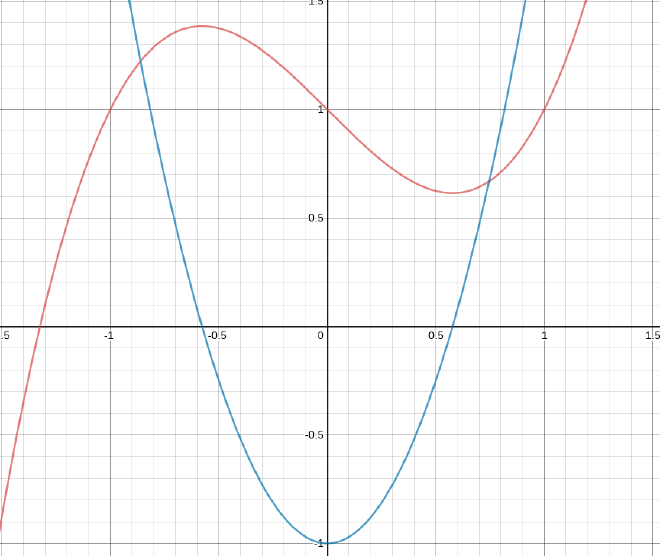Section 2.2
Table of Contents
The derivative
The derivative as a function #
In the previous section, we found the derivative at a point which is a number.
We will consider the function $f’(x)$ given by: $$ f’(x) = \lim_{h\to 0} \frac{f(x+h) -f(x)}{h} $$ which gives the slope of the tangent line to the function $y=f(x)$ at any point $(x, f(x))$, whenever that limit exists.
Example: #
Let $f(x) = x^3 - x + 1$
- Find the derivative $f’(x)$ of the function.
- Graph both $f$ and $f’$ on the same coordinate axes.
Here’s the graph
Click to reveal the answer.

Example #
Find the derivative of $f(x) = \sqrt{x-1}$ State the domain of $f’$.
Example #
Find the derivative of $\displaystyle f(x) = \frac{2+x}{1-x}$
Other Notations #
We’ll see many different notations both in this class and outside.
When a function is defined $y=f(x)$, we might write any of the following, which all mean the same thing:
- $f’(x)$
- $y’$ <— this notation we refer to as Newton’s notation1.
- $\displaystyle \dfrac{dy}{dx}$ <— these are referred to as Leibniz notation2
- $\displaystyle \dfrac{df}{dx}$
- $\displaystyle \dfrac{d}{dx} f(x)$
- $\displaystyle D_x f(x)$ <— you’ll see this in Calc 3 and differential equations
- $\dot{y}$ <— this is actually Newton’s notation from Principia. Physicists often use this in homage to Newton.
If we want to evaluate the derivative of $y=f(x)$ at $x=a$, we can write:
- $f’(a)$
- $\displaystyle \frac{dy}{dx} \Large|_{x=a}$ <— a vertical bar saying “derivative at this number”
- $y’(a)$
As I said above, they all mean the same thing. If you’re ever unsure of notation, please ask!
Differentiability #
Definition #
A function $f$ is differentiable at $a$ if $f’(a)$ exists. It is differentiable on an open interval (a,b) [or $(a, \infty), (-\infty, b), \text{ or } (-\infty, \infty)$] if it is differentible at every number in the interval.
Example #
Polynomials, sine and cosine are nice and differentiable on $(\infty, \infty)$. Their derivatives, for reasons we’ll see later, are still polynomials, -cosine, and sine, respectively, whose domains are all real numbers.
Are there functions that aren’t differentiable?
Example #
Where is the function $f(x) = |x|$ differentiable?
When is a function not differentiable? #
-
Discontinuities
-
Cusps
-
Vertical tangents.
VIDEO HERE
Higher Derivatives #
The second derivative is the derivative of the derivative of a function. For example, if $y=f(x)$, we’ll write:
- The first derivative if $f’(x)$ or $\dfrac{dy}{dx}$.
- The second derivative is $f’’(x)$ or $\dfrac{d^2y}{dx^2}$.
Example: #
Let $f(x) = x^3 - x + 1$, find $f’’(x)$
NOTE: we did $f’$ above
Even higher derivatives: #
Yes, we’ll go higher. We’ll see 3rd and 4th derivatives (and more in calc 2).
- $f’’’(x)$ is the third derivative <— last of the tick marks
- $f^{(4)}(x)$ is the fourth derivative
- $f^{(5)}(x)$ is the fifth derivative
- … and so on; the parentheses around the number mean derivative not exponent.
Physical interpretation of derivatives? #
Velocity is derivative of position with respect to time. …. Acceleration is derivative of velocity with respect to time.
Posting that video might make me seem like a jerk. But that’s $f’’’(x)$3.
Now practice! #
Head over to WebAssign and work on section 2.2. If you have questions, post them here, and either I or a fellow student will answer them quickly!
-
This isn’t what Newton wrote, though… ↩︎
-
Both Isaac Newton and Gottfried Leibniz invented calculus at the same time and separately. Long, and very interesting story. I teach a history of math class, by the way 🙂 ↩︎
-
Dad and math joke! 😆 Jerk is the third derivative https://en.wikipedia.org/wiki/Jerk_%28physics%29 ↩︎